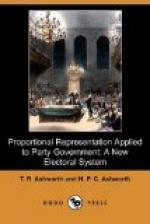+A Change in Electoral Machinery the Key to Reform.+—The great mistake made by all writers on electoral reform is that they have failed to recognize that the character of public opinion depends upon the way it is expressed. If the electoral machinery be adapted to give effect to those principles of organization and leadership which lie at the root of representation, then the character of public opinion will be improved. Representation, in fact, is not only a means of expressing public opinion, but also of guiding, informing, educating, and organizing it. Therefore, the method of election is an all-important factor.
The first and greatest necessity is to counteract the tendency of the people to split up into factions. It may seem a startling conclusion that this is a mere matter of electoral machinery, but it is nevertheless quite true. It must be remembered that we are dealing with human beings and not with insentient figures. If the method of election allows representation to two sections only, the people will group themselves into two sections. But if it allows representation to a large number of sections, then the people will group themselves into as many sections as are allowed. Now, party government offers every hope of preventing two sections degenerating into factions, but with a number of sections there is absolutely none.
Here, then, we see the one great merit of the present system of election, which explains why it has persisted so long, with all its faults. It is that it tends to confine representation to the two main parties, since each electorate is generally contested by them; but in so far as it does not completely effect that object and allows representation to independent factions it is defective. Moreover, the merit we have indicated is purchased at too high a price. It is these defects which are causing the degradation of representative institutions throughout the world to-day.
It is obviously impossible to give a just share of representation to two parties and allow each party to elect its most popular leaders, in an electorate which returns only a single representative. Hence the first necessity for reform is to enlarge electorates, so that each may return several representatives. Now, the requirements for giving effect to the principles of organization and leadership in such an electorate are:—
1. Proportional
representation to the two main parties—Ministerial
and Opposition, the
majority and the minority.
2. The election
by each party of its most popular
candidates—i.e.,
those most in general favour with all sections
of the party.
This is the problem of representation as it presents itself to us. Leaving a detailed account of the means by which it is proposed to give effect to these great desiderata to a later chapter, let us indicate briefly where they strike at the root of the evils of the present system.




